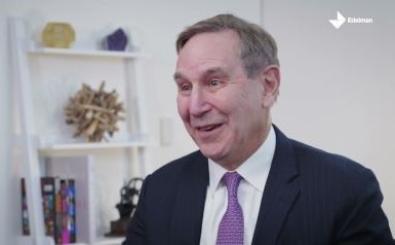The challenge of delivering the right message at the right time to the right people is one that people in Brussels face all the time.
Whether you would like to create a better brand presence in Brussels, convince decision-makers to introduce something new or build a pool of supporters – you'll need to break through the noise.
The first instinct of most public affairs teams is to go direct. Target a policymaker and set up a meeting with them; make your case face-to-face and be sure you've gotten through.
That's obviously very effective. But policymakers take a lot of meetings, so you want to ensure that your messages are memorable and that the policymaker you meet with hears what you have to say.
But how do you do that? One very impactful way is grassroots campaigning!
Earlier this year, when Brussels was dominated by the European Elections, we collaborated on a grassroots campaign with Eurochild, a network of organizations and individuals working across Europe to promote children’s rights.

We put together a step-by-step guide to grassroots campaigns to help you understand the importance of grassroots engagement that can be the key to staying top-of-mind for your target policymakers.
1. Define your issue
To work towards your goal, you need to first identify your key challenges and define an outcome that you would like to see.
Although being a central hub for Europe and based in Brussels, Eurochild wanted to build up their existing contact list but hadn't run many external campaigns to put them on the map. They came to us to kickstart a new focus on external campaigns.
We helped them build a campaign around a specific goal: calling for the creation of a new EU Commissioner for Children.
Dear Mr. Tusk @eucopresident
We've eased your work this week.
A title and a job description are ready for you to instate a #ChildCommissioner
Thanks for your consideration with #EU leaders #EUCO #ChildRights
💌https://t.co/tvtOUfZL78 pic.twitter.com/l38TWx0P2T— Eurochild_org (@Eurochild_org) June 27, 2019
2. Find the right audiences in the right places
The way people consume media has changed immensely. Digital and social platforms and channels have become necessary parts of reaching your target audiences and building trust. Internet users are now spending an average of 142 minutes per day on social networking and messaging platforms.
Engaging constituent audiences at the grassroots level is a powerful component to connect with individuals who support your values and inspiring them to act in support of your goals. Network organizations like Eurochild need a single rallying course to get a campaign in front of as many people as possible.
We identified the main groups of people that would be interested in the campaign: This included online communities like parenting and teenager forums, childcare networks, women portals, discussion platforms on EU-topics or civil society associations.
The key to building buzz in those communities is to learn how to post on those forums and focus on offering value to the ongoing conversation.
EAP supports the @Eurochild_org campaign for a #EU #ChildCommissioner! 🧒🇪🇺
Despite recent progress, there's still a long way to go to fully secure children's rights, including #health ones.
Do you also want a #ChildCommissioner in the next @EU_Commission? Sign the petition ⬇️ https://t.co/4eKSBQbWsS— European Academy of Paediatrics (EAP) (@EAPaediatrics) July 19, 2019
3. Deliver engaging content that educates and energizes
Today’s digital landscape with all its communications channels has created endless noise. This makes it very easy to be ignored. To break through the noise and be heard, you need to bring a campaign to life that clearly signals what your organization stands for and who you are.
Content your grassroots community wants to engage with and eventually share needs to be easily accessible and communicate a clear message.
We helped Eurochild build a tongue-in-cheek landing site and an online petition. The team focused on the seemingly incongruous fact that there is no EU Commissioner focused on children yet there is one focused on fish - this was a surprising fact that also plays into the fact that many Europeans don't have a solid grasp on what the Commission does or is responsible for.
So we asked the question: "What's more important: Children or Fish?". Eurochild then asked people to share their content and spread the word by using the memorable hashtag #ChildCommissioner.
10 years since EU recognised #childrights but no #ChildCommissioner to enforce them! This is the #EUtopjobs worth fighting for! Join me by signing the petition of @Eurochild_org. https://t.co/XrtkSqU7Ah
— Marie-Louise Coleiro Preca (@MarieLouise_MT) June 26, 2019
4. Be able to prove the value created through your campaign
Whether your organization is advocating for change or simply raising awareness, showing the progress of your campaign by posting it online or making your grassroots supporters convene at a certain public space can be very effective to show the size and volume of your voice.
Since launching at the end of June 2019, Eurochild’s petition has received almost 3,000 signatures. Their campaign content was shared by multiple MEPs, the former president of Malta as well as EuroNews and UNICEF. The organization shared these milestones via social media and tagged supporters to thank them, which created further traction around their campaign.
Grassroots Campaigning is Best Practice
Grassroots engagement is more important than ever. The 2019 Edelman Trust Barometer report shows that businesses are more trusted than governments. Brands are expected to take a larger role in society with more and more people becoming belief-driven. This implies that the expectations of voters for political engagement are also increasing.
Whether you’re educating and empowering your audience or compelling them to take action, grassroots campaigning can be a powerful way to build bridges between individuals and decision makers or simply to build a list of supporters that you can reach out to frequently.
Partnering with like-minded individuals or organizations can make your voice hard to ignore by people that usually get contacted a lot in Brussels. While volume alone isn’t always enough to bring change on an issue, enabling your advocates to easily share content that they happily support can help break through the noise.







